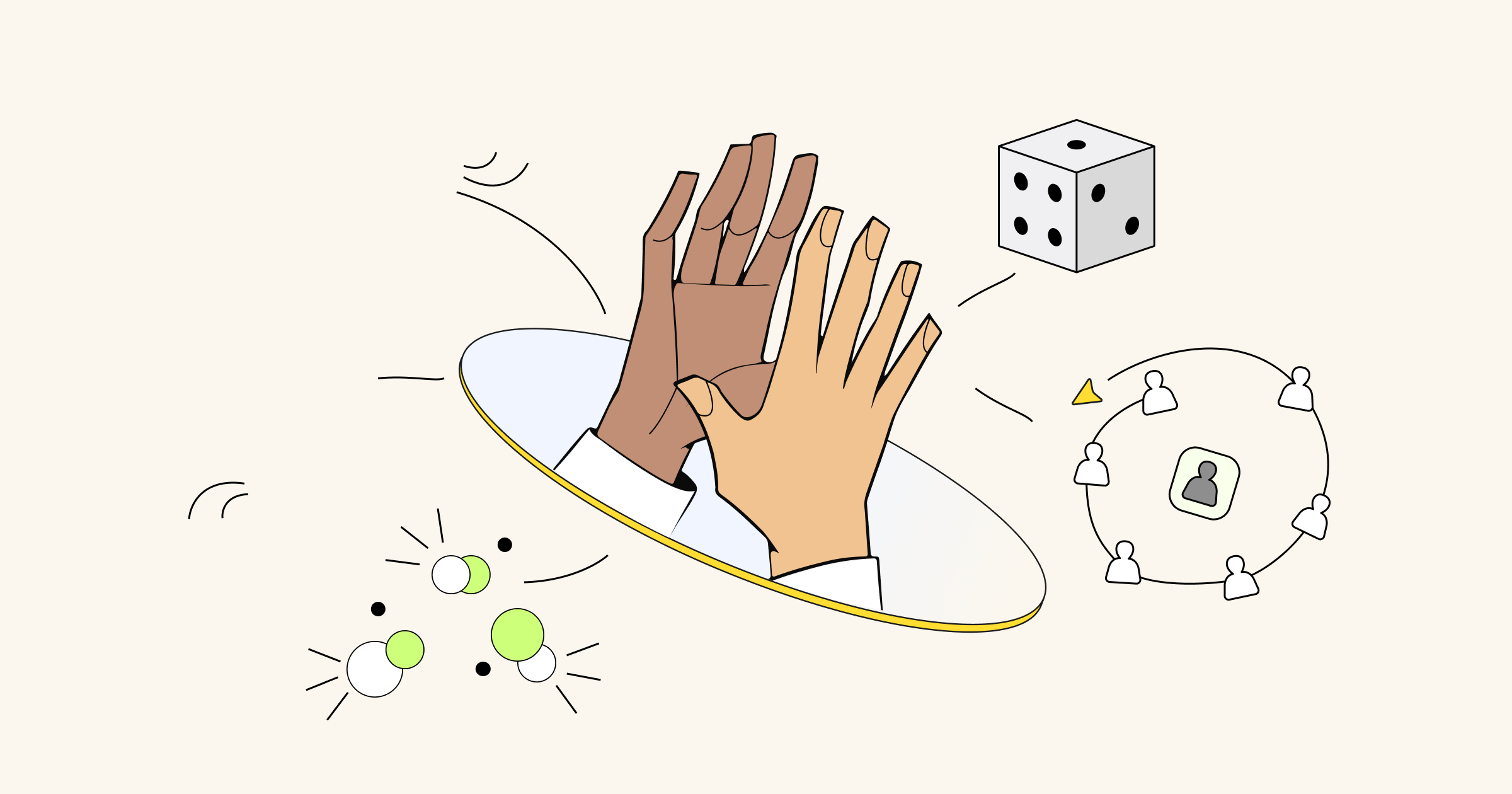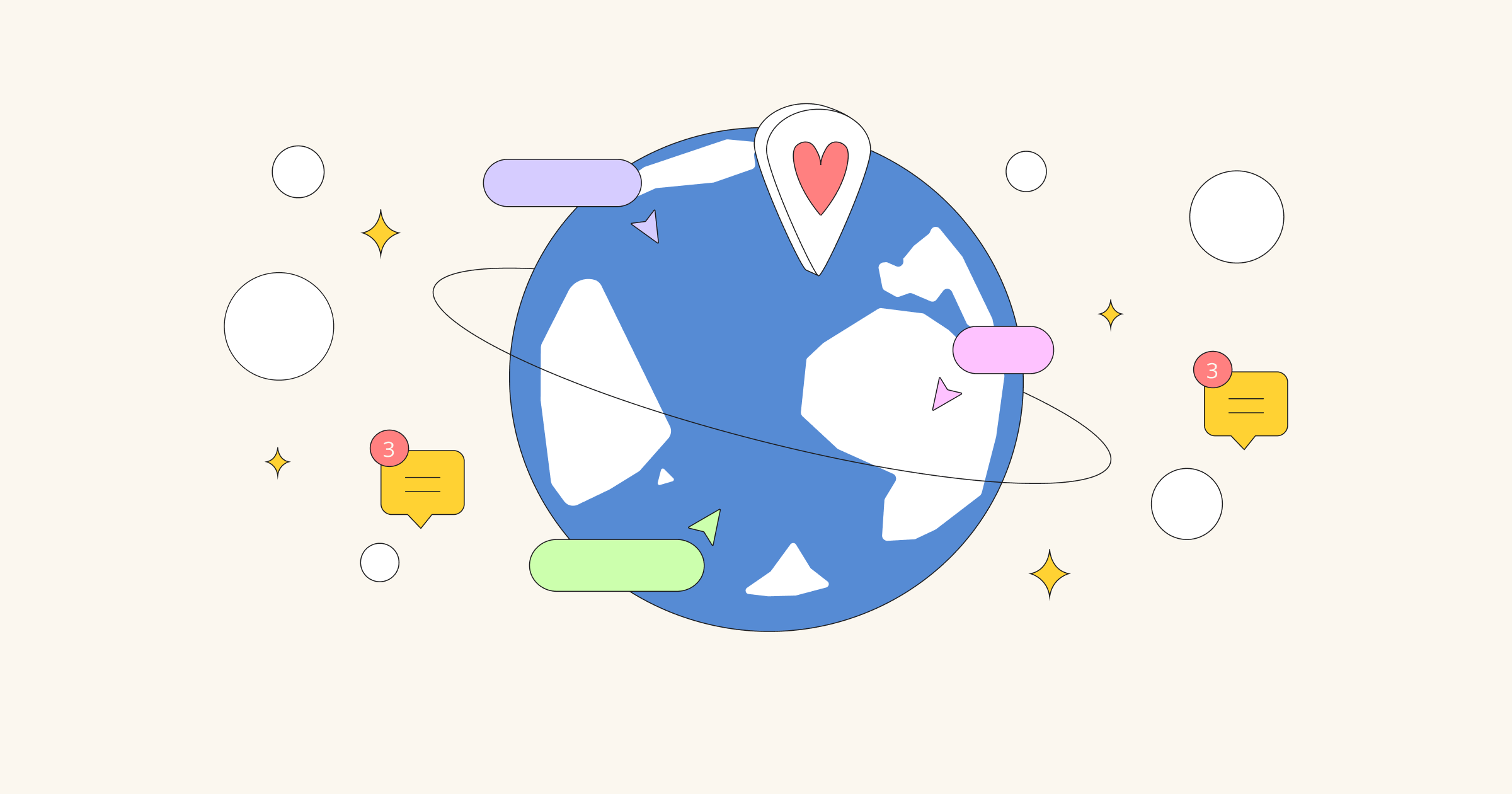For much of Miro’s nine-year history, our team has had the annual tradition of gathering in one city for a week-long offsite dedicated to team-building and unifying around our goals and vision for the year.
The opportunities for forging bonds extend well beyond planned activities. Jet-lagged travel stories of being lost in foreign countries have become the foundations for friendships among members of our team, and they contribute to the shared experience of being a Mironeer.
Unfortunately, 2020 put the kibosh on many beloved traditions, and Miro’s summer offsite was no match for COVID-19. But after an initial shock of disappointment, we realized that this was a perfect opportunity to stress-test the state of virtual events and see if it’s possible to build, coalesce, and energize a team entirely virtually — even when many members have never met each other in person. Thus, the 2020 Virtual Offsite was born, and Miro’s People team was tasked with the tall order of designing it.
“There’s not really a word that exists for what we were trying to do with this event — at least not in a corporate setting,” Miro’s Head of People AJ Josephson explained. “We needed to create memorable social interactions among people who are meeting for the first time, with the caveat that they are stuck inside their homes and communicating virtually.”
His team knew the event needed to be interactive, exciting, and include games and other activities that would plant the seeds for rewarding professional relationships.
Thanks to Miro’s People Team and all the others who helped execute, the event was a big success. Below, we’re excited to share lessons learned in making an engaging virtual offsite.
Interactivity baked into every session
One of the hardest parts of planning a virtual event is building a program that drives engagement. Miro’s Onboarding Learning Designer Dorothy Mankey explains this challenge simply.
“In real life, I can look around a large room at all of the participants in small groups and I can see their body language, I can guess who needs help or who is already finished with the task, or see a group where someone is not engaged,” she said. “In planning for our offsite, I tried to find ways to use our product that would give me some of those same signals.”
During our offsite, interactivity was a core part of every session. We used Miro to collaborate, used Zoom for video conferencing (often in breakout rooms), and frequently used Slack concurrently for chats that could feature rich emojis and gifs. Here are a few of the most memorable ways Miro was used to create interactive and collaborative experiences.
The time we raced to assemble a puzzle of our CEO’s face
As a warm-up activity to one workshop, we were split into teams in Zoom breakout rooms, and found in Miro that each team had a designated frame with puzzle pieces scattered in it. In this particular exercise we had to work silently to assemble the puzzle, which turned out to be the face of our CEO, Andrey Khusid.
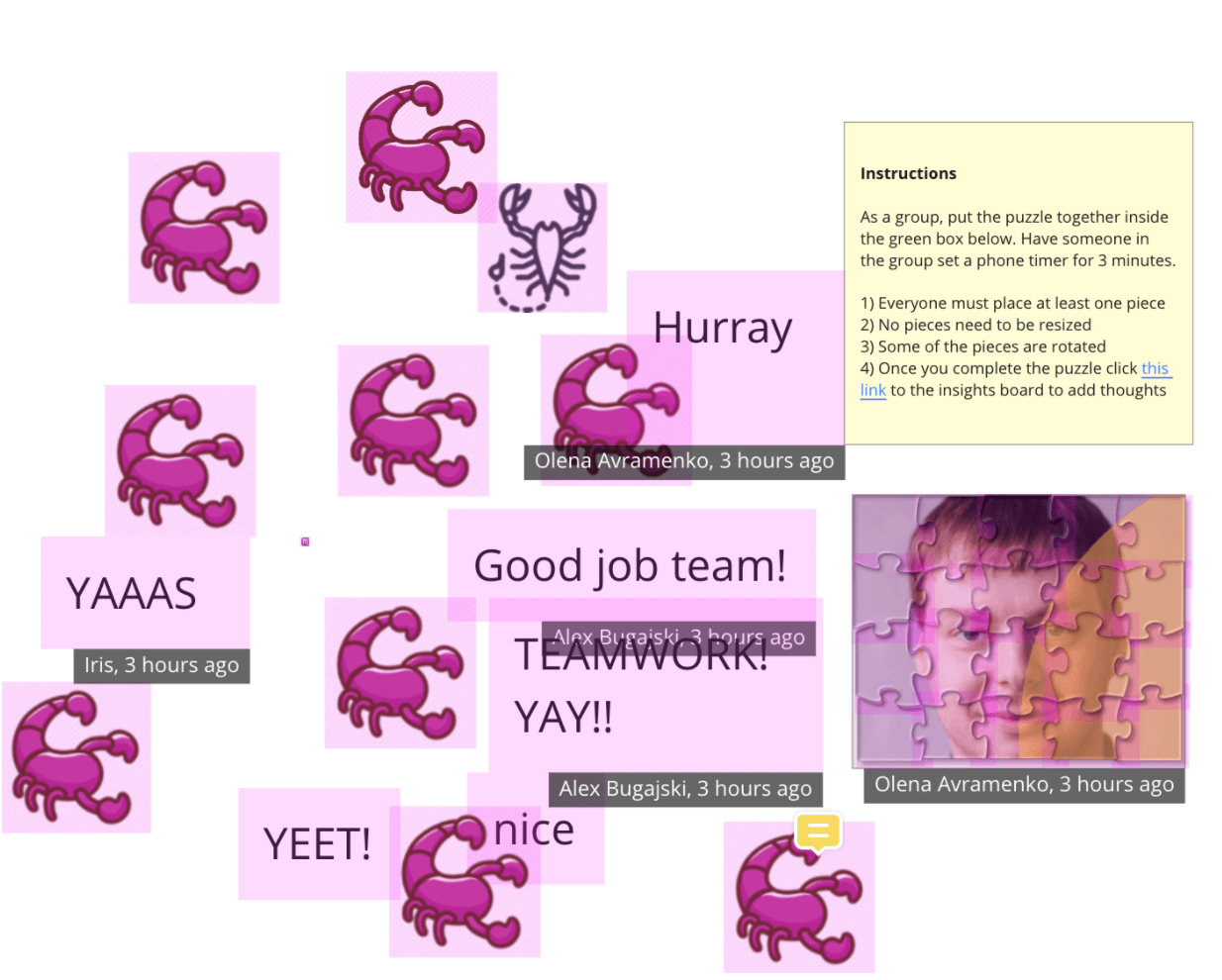
The time we turned ourselves into superheroes
In a self-discovery exercise, everyone at Miro turned themselves into superheroes by picking an animal avatar that represented our workstyle and dressing it in costumes that represented our strengths and areas for improvement. Of course, some people were sillier (er, more creative) than others.

The time we conducted the world’s biggest retro
Fun and games were just a part of the offsite. We also wanted to look inward and find ways to improve the company and culture. That’s why we held an event called “The World’s Biggest Retro,” in which 400+ Mironeers joined a single board at the same time to suggest ways to make Miro a better workplace and company. You can find a retro template for your team in our Template Library.
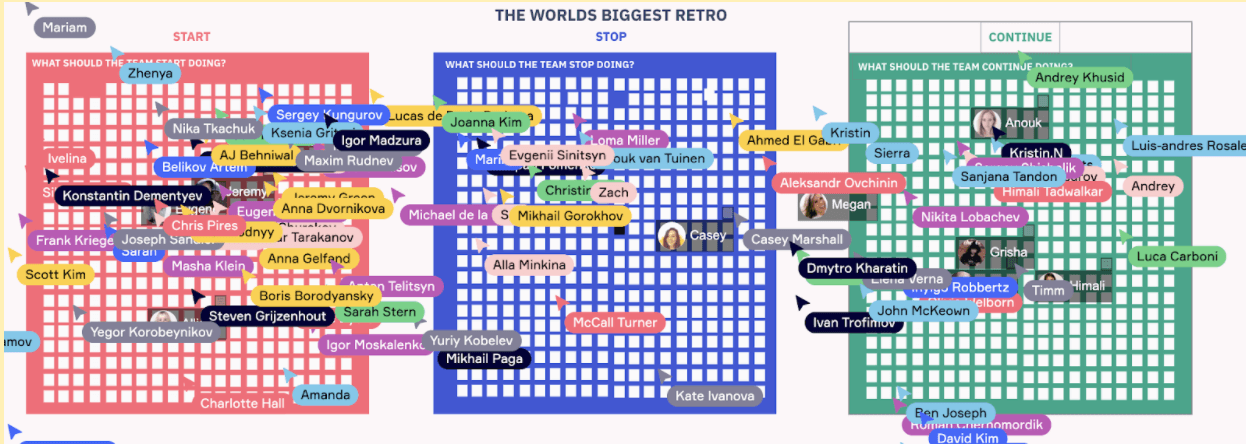
The time we solved a murder
If you’ve ever seen a movie where the police are on the hunt for a criminal mastermind, you may recall networks of tacks, strings, Polaroid photos, and sticky notes detectives have pinned to a bulletin board to build their case.
It turns out that Miro’s visual workspace is a perfect tool to bring the hunt online, and we used it during a virtual online Murder Mystery party game that we played together as a team (see more about that later).
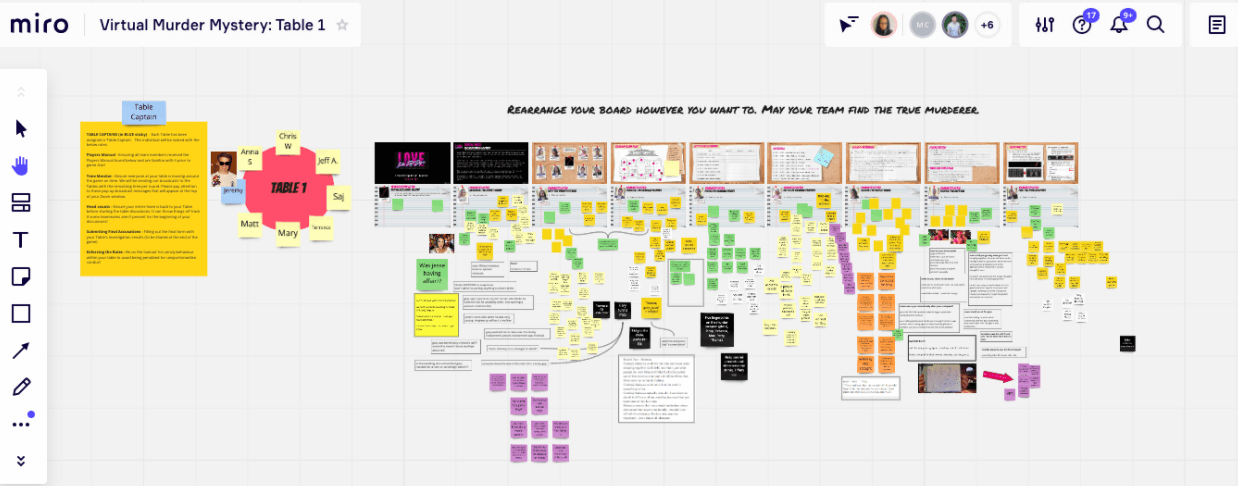
Guest speakers bring fresh perspectives
To develop an engaging program that brought new perspectives into our organization, the planners of our offsite invited several outside speakers to share their points of view.
One of our speakers was Atlassian’s Dom Price, who presented on “Envisioning the Future of Work” and left us with a few points of wisdom that became rallying cries for the rest of the week. He shared a quote from Author Daniel Pink: “Argue like you’re right, but listen like you’re wrong.” When he said this, I could see the Zoom chat lighting up with people typing “+1” to affirm this quote.
We also had a panel discussion featuring Silicon Valley pioneers and Miro investors Bob Muglia, Irene Au, and Bradley Horowitz who answered questions about the evolution of the SaaS market, their vision for the future, and how they see Miro fitting in. It was inspiring to hear their perspectives on Miro’s success and their vision for the opportunity we have ahead of us.
To help make these virtual panels visually interesting, Miro hired Bea Broskova, a Czech artist and facilitator who specializes in visual note-taking. Here’s her drawing of the Investors panel:

One of the highlights was the opportunity to hear from NBA legend Stephen Curry for a Q&A with our CEO, Andrey Khusid. Stephen became an investor in Miro in 2019, and our offsite was the first chance our team had to hear from him directly (via Zoom).
Curry’s starpower alone would have been enough to pack a punch at the event and energize our team, but he also had profound and insightful things to teach us about teamwork and resilience. You can read a summary of his Q&A and the words of wisdom he imparted on our team.
5 vendors that created memorable experiences
For the team-building portions of the program, we hired some excellent vendors specializing in helping teams collaborate or compete to have a good time.
Virtual experiences included:
- Virtual Cocktail Making from Airbnb Experiences. Our host Meggan had years of experience in high-end bartending, and taught us to make Whiskey Sours and Daiquiris from scratch. To stock our home bars with supplies, Miro used Cocktail Courier to send us cocktail kits at home. We had a great time following each other’s progress via Zoom.
- CozyJuicyReal – CozyJuicyReal is an online board game designed to help groups move beyond small talk. CJR is hosted by its creators and run entirely within Miro. Jed and Soph Lazar, and they always do an amazing job facilitating the game and helping teams play. Plus, playing the game in Miro helped inspire team members with a creative and fun look at our product in action.
- Living Room Legend From AirBnB Experiences – This virtual Scavenger hunt that had us all darting through our home finding odd items called out by our host. With rapid fire challenges like “You have sixty seconds to put on your best ‘80s costume,” we all returned to our Zoom windows to admire the weird look into each other’s lives.
- The Go Game: This trivia-based live game show broke groups into teams and pitted us against each other with general knowledge questions. This was the only team building event not run via Zoom, and I was impressed with the web app that allowed us to breakout for group discussions and submit answers very smoothly.
- Love in the first Degree: A Virtual Murder Mystery – This virtual experience created by Moniker Partners was a fun mystery set at an ‘80s wedding, where the Groom mysteriously ends up murdered. It featured a talented and very funny cast of young actors and actresses who brought the story to life and allowed the amatuer sleuths on our team to flex their detective muscles.
Closing the week with self-reflection
Our virtual offsite closed with self-discovery activities that gave us the opportunity to redesign Miro’s values as a group, and the space to individually look inward and write our own visions for happiness.
In one session, Miro’s Learning Design Program Lead Anya Dvornikova walked the entire company through the process of evaluating our values and suggesting ways to update them for 2020 and beyond. As a new member of the team, I was impressed that Miro’s leadership democratized this process and invited all employees into it.
The session was run in Miro and also utilized breakout rooms in Zoom to accommodate smaller groups. Bea Broskova illustrated our process:
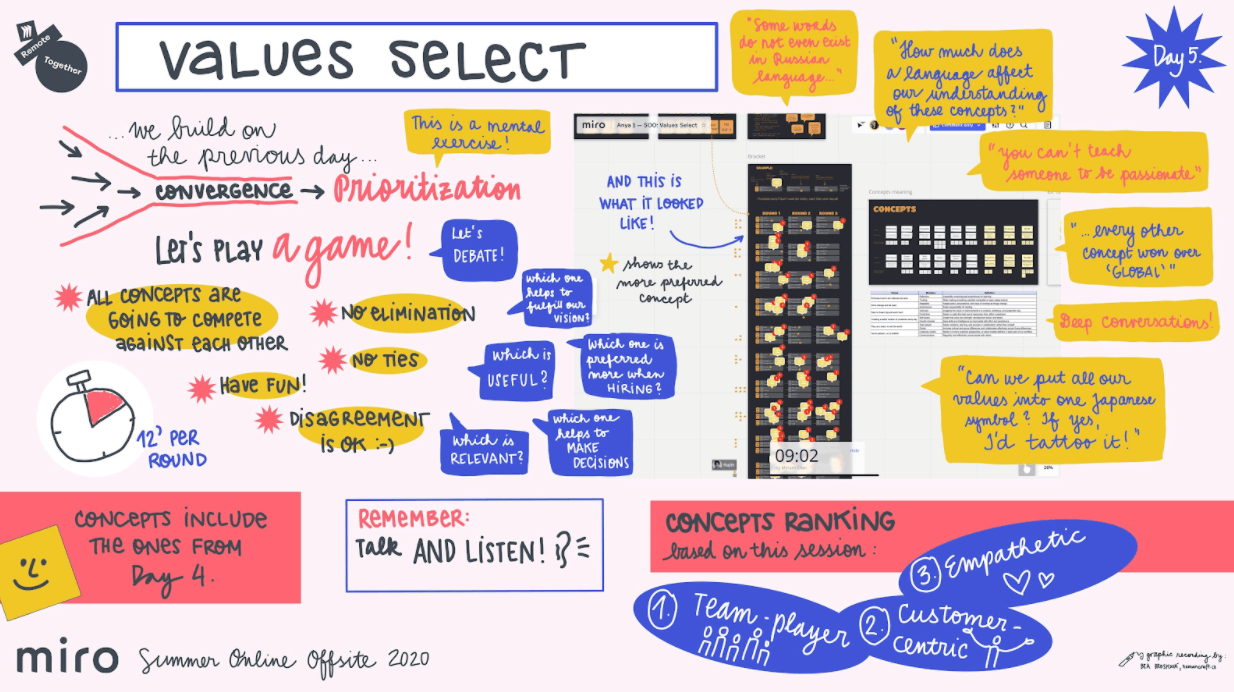
The final session was a self-reflection exercise called U-Journaling, hosted by our Head of People, AJ Josephson. U-Journaling is a personal process in which you look at yourself objectively from the outside and write down key observations about yourself and your sources of happiness, energy, and frustration.
AJ led our team through the questions and we quietly wrote our answers. Afterward, a few people expressed that the experience was emotional for them, which spoke to the power of self-reflection, even when facilitated virtually.
For virtual events, planning & interactivity are key
At the end of our offsite, I signed out with hope for the state of virtual events. I saw that in order to be successful, you need to prioritize interactivity and driving social interactions as much as conveying information.
At Miro, our product is also our internal competitive advantage. We are all avid users of our software, which helps bridge the virtual gap by bringing us together and giving us a way to connect with each other, learn in an engaging way, and collaborate smoothly.
Along with choosing the right vendors and nurturing the right culture, Miro’s product was a key piece of the puzzle for overcoming distance and bringing our organization together, as if we’re in the same room.

